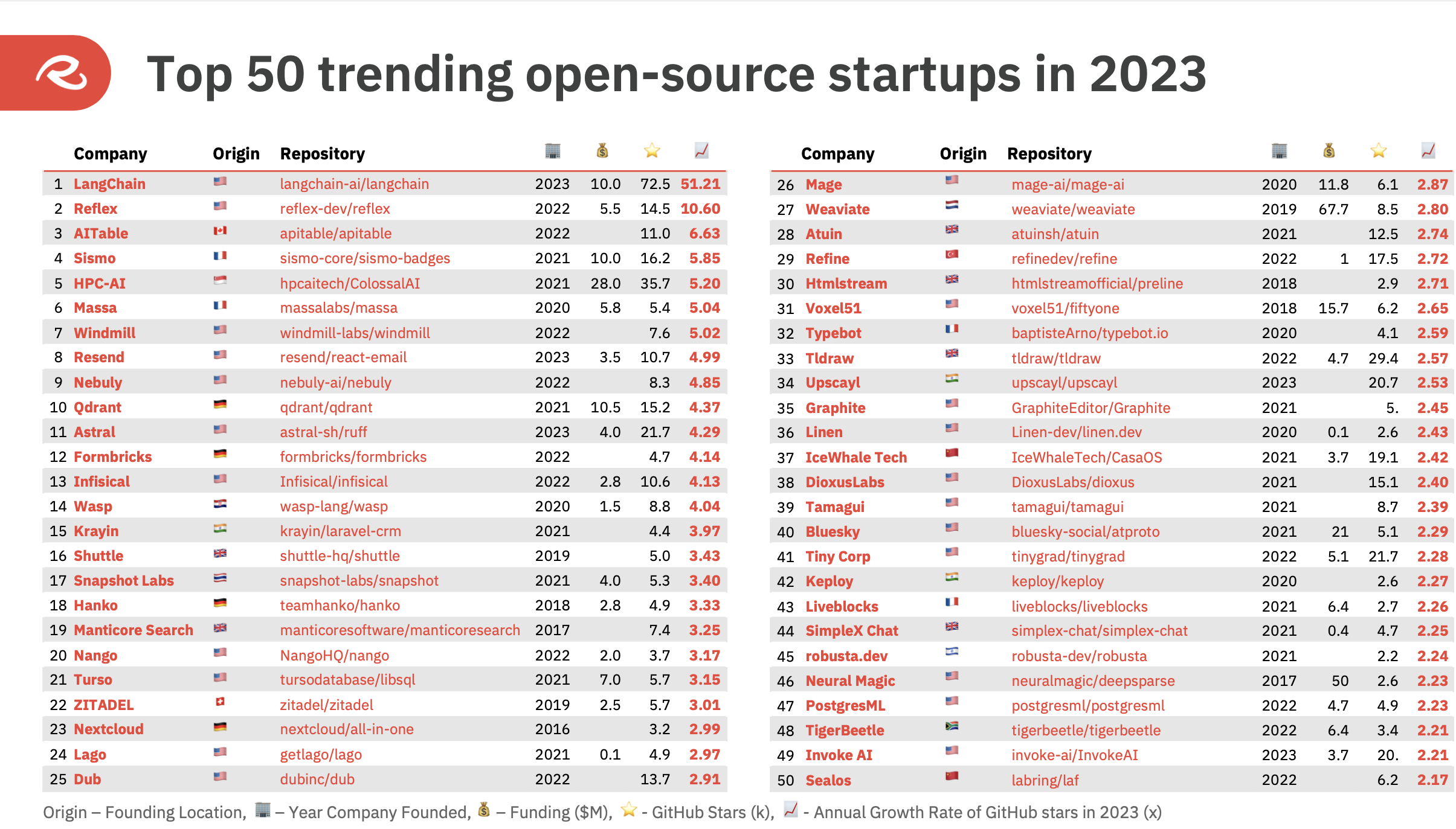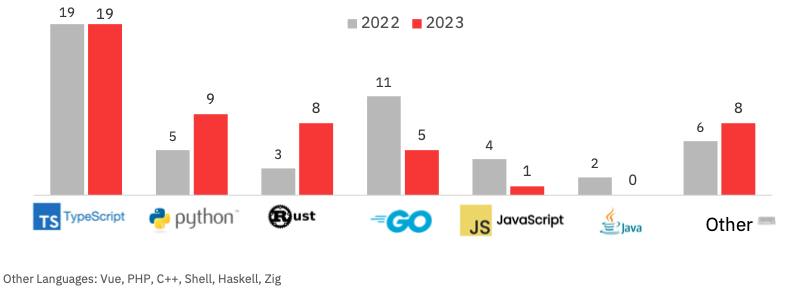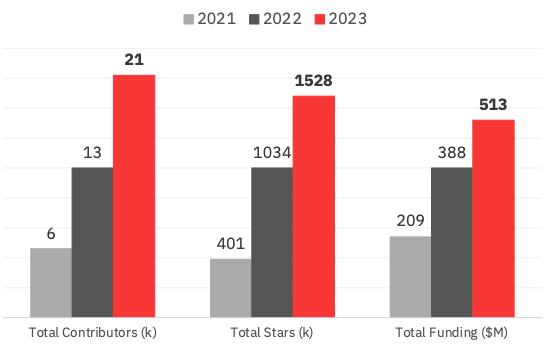Artificial intelligence and data infrastructure are driving demand for open source startups

[ad_1]
New report It highlights the demand for startups building open source tools and technologies for the rising AI revolution, with adjacent data infrastructure verticals also heating up.
Rona Capitala venture capital (VC) firm that consolidated its Silicon Valley assets and moved its headquarters to Luxembourg in 2022, published Runa Open Source Startup (rus) index for the past four years, highlighting the fastest-growing commercial open source software (COSS) startups. The company publishes quarterly updates, but last year it released its first annual report taking a top-to-bottom look at all of 2022 — which it now repeats for 2023.
trends
Data is closely aligned with AI because AI relies on data to learn and make predictions, and this requires infrastructure to manage the collection, storage, and processing of that data. These cross trends collide in this report.
Reaching first place in the ROSS Index for the past year was langshena two-year-old San Francisco-based startup that has evolved Open source framework To build applications based on large language models (LLMs). The company’s flagship project surpasses 72,500 stars in 2023, with Sequoia continuing to Led $25M Series A round to LangChain Just last month.
Top 10 COSS Startups in the ROSS Index 2023 Image credits: Rona Capital
Elsewhere in the top 10 is reflexthat Open source framework To create web applications in pure Python, the company behind the product recently received a seed investment of $5 million; AITablecreator of spreadsheet-based chatbots and the like Airtable is open source competitor; Sismoa privacy-focused platform that allows users to Selectively disclose personal data For applications; HPC-AI, which is building a distributed platform for AI development and deployment in an effort to become something like Southeast Asia’s OpenAI; and open source vector database Qdrant, which recently secured $28 million to capitalize on the burgeoning AI revolution.
A broader look at last year’s “Top 50 Open Source Startups” reveals that more than half of them (26 companies) are related to AI and data infrastructure.

COSS Top 50 Startups in the ROSS Index 2023 Image credits: Rona Capital
It’s difficult to properly compare the 2023 index to the previous year from a vertical perspective, largely due to the fact that companies often pivot or reposition their products to fit what’s trending today. With the ChatGPT hype train running full steam ahead last year, this may have caused early-stage startups to change their focus, or even focus more on the existing “AI” element of their product.
But as Generative AI breakthrough yearit’s easy to see why demand for open source components has skyrocketed, as companies of all sizes look to keep up with AI giants like OpenAI, Microsoft, and Google.
Geography
Open source software has always been highly distributed, with developers contributing from all over the world. This ethos often translates to open source business startups that may not have a traditional center of gravity based on a brick-and-mortar headquarters.
However, the ROSS Index goes some way towards bringing geography into the picture, reporting that 26 companies on the list have headquarters in the US, although 10 of these companies originated elsewhere and still have founders or employees based in the US. In other regions.
In total, the top 50 companies came from 17 separate countries, with 23 companies registered in Europe – a 20% increase on the previous year’s index. France counted the largest number of COSS startups with seven companies, including… Sismo And Massa It is in the top ten, while the UK has risen from just one startup in 2022 to six startups in 2023, placing it in second place from a European perspective.
Other notable tidbits to come out of the report include programming languages, with the ROSS index recording 12 languages used by the top 50 last year, up from 10 in 2022. writing machineThe comprehensive JavaScript suite developed by Microsoft remains the most popular, used by 38% of the top 50 startups. Both Python and Rust have increased in popularity, with Go and JavaScript declining.

ROSS Index: Popular Programming Languages. Image credits: Rona Capital
The top 50 participants in the ROSS Index collectively gained 12,000 contributors in 2023, while the total number of GitHub stars increased by nearly 500,000. The index also reveals that funding provided to the top 50 COSS startups last year reached $513 million, a 32% increase over In 2022 and 145% in 2021.

ROSS Index: Contributors, Stars and Finance Image credits: Rona Capital
Methodology and context
It is worth looking at The methodology behind all this – What factors influence whether a company is considered “hot”? For starters, all companies included You must have at least 1,000 stars on GitHub (GitHub’s metric is similar to “likes” in social media) to be considered. But the number of stars alone doesn’t tell us much about what’s popular, since stars accumulate over time, so a project that’s been on GitHub for 10 years is likely to have accumulated more stars than a project that’s been around for 10 months. Instead, RONA measures the relative growth of stars over a given period using the annual growth rate (AGR) – this looks at the value of stars now versus a previous similar period to see what has grown more impressively.
There’s a degree of manual curation here, too, since the goal is to attract open source “startups” specifically — so Runa’s investment team pulls in projects that belong to a “product-focused business organization”, which has been founded for less than Ten years with known funding of less than $100 million.
Defining what constitutes “open source” has its inherent challenges as well, as there is a wide range of how “open source” a startup can be – some akin to “open kernel”, where most of their key features are locked behind a premium paywall, some It has more restrictive licenses than others. For this reason, Runa decided that the startup should simply have a “rreasonably linked to their open source repositories,” which obviously involves a degree of subjectivity when deciding which ones to cut.
There are more nuances at play too. The ROSS Index espouses a particularly liberal interpretation of “open source” – e.g. Both are flexible MongDB has abandoned its open source roots for “available source” licenses, to protect itself from being exploited by major cloud providers. According to the ROSS Index methodology, these two companies would be classified as “open source” – even though their licenses have not been officially approved as such by the US Securities and Exchange Commission. Open source initiativeThese typical companies no longer refer to themselves as “open source.”
Thus, according to Rona’s methodology, she uses what she calls the “commercial perception of open source” in her report, rather than the actual license the company grants to its project. This means that restricted source licenses are available such as BSL (Works Source License) f SSBL (Server-Side Public License), which MongoDB introduced as part of its transition away from open source in 2018, is pretty much on the list as far as businesses in the ROSS Index are concerned.
“Such licenses preserve the spirit of open source software — all its freedoms, except for slightly limited redistribution, which does not affect developers but gives original vendors a long-term competitive advantage,” Konstantin Vinogradov, general partner of London-based Runa Capital, explained to TechCrunch. “From a venture capital perspective, it’s just an evolving guide for exactly the same type of company. The definition of open source applies to software products, not companies.”
There are other notable filters out there as well. For example, companies that focus mostly on providing professional services, or side projects with limited active support or no commercial component, are not included in the ROSS Index.
For comparison purposes, there are other indexes and lists that provide guidance on what’s hot in the open source scene. Another VC firm called Two Sigma Ventures holds Open source indicatorfor example, which is similar in concept to Runa, except that it includes all types of open source projects (not just startups) and has additional filters, including the ability to view by GitHub’s “watchers” metric, which some argue gives a more accurate picture. Accuracy to the real popularity of the project.
GitHub itself also publishes a Warehouses are trending The page, which is similar to Two Sigma Ventures, does not focus on the business behind the venture.
So the ROSS Index has emerged as a useful complementary tool for knowing which open source “startups” specifically are worth keeping an eye on.
[ad_2]
Source link




